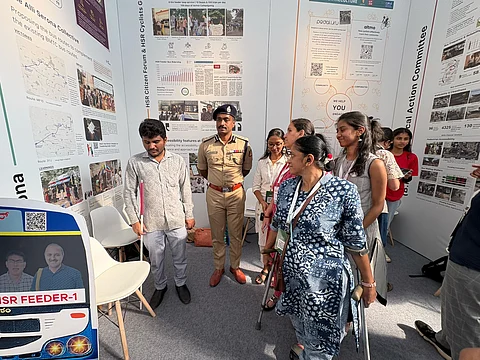

A staggering 70 vehicles break down on various stretches of the Outer Ring Road every day, impacting the daily movement of vehicles. Addressing Bengaluru’s mounting traffic crisis, Joint Commissioner of Traffic MN Anucheth said, “A single bus breakdown on a flyover can paralyse traffic for kilometres. Our priority is rapid incident response.” He was speaking in a session titled “How Do We Manage Bengaluru’s Traffic?” at Namma Raste 2025—an initiative dedicated to creating a safe, inclusive, and climate-resilient Bengaluru launched by Bruhat Bengaluru Mahanagara Palike (BBMP).
Reflecting on the high vehicle population and road network spanning 14,000 km, he said that managing the city's growing congestion despite 6,200 traffic personnel remains a major challenge, making technology integration crucial.
“Our primary goal is to keep traffic moving efficiently. Over the past few years, our approach has shifted from strict enforcement to management and regulation. We must stop relying solely on expanding roads and instead focus on optimising mobility,” he said. Stating that their approach was on moving people and not vehicles, Anucheth said, "The problem is office commute not other commute so companies and everyone must encourage public transport usage."
He also pointed out that Bengaluru’s 12 high-density corridors, spanning 220 km, handle nearly 60% of the city’s traffic and account for a similar percentage of accidents.
Speaking about the impact of artificial intelligence (AI) and data analytics on traffic management, he said, “We have integrated AI-driven traffic signals and big data platforms like Astrum to monitor congestion, detect violations, and improve traffic flow.” He recalled past failures in adopting technology, such as an unsuccessful attempt in 2017 to implement facial recognition trained on Caucasian datasets, but noted that advancements have made such systems more viable now.
Anucheth described Bengaluru’s approach to speed regulation as a “judicious mix” of human oversight and AI-based monitoring. “We’ve strategically deployed speed cameras along high-risk corridors to reduce fatal crashes,” he said, adding that Bengaluru was the only metro to record a reduction in traffic fatalities last year.
When asked about the city’s infrastructure’s ability to self-regulate traffic, Anucheth highlighted the success of AI-driven signals. “We have implemented 28 junctions with AI-based traffic signals, and 13 have functioned without manual intervention. As the technology improves, we will transition from human-operated signals to AI-managed enforcement,” he said.
Calling for reducing dependency on private vehicles, he said, “Public transport systems must be prioritised for peak-hour commutes. We need policies like congestion pricing which discourages single-occupancy vehicles and incentivises buses, metro, and shared mobility.”